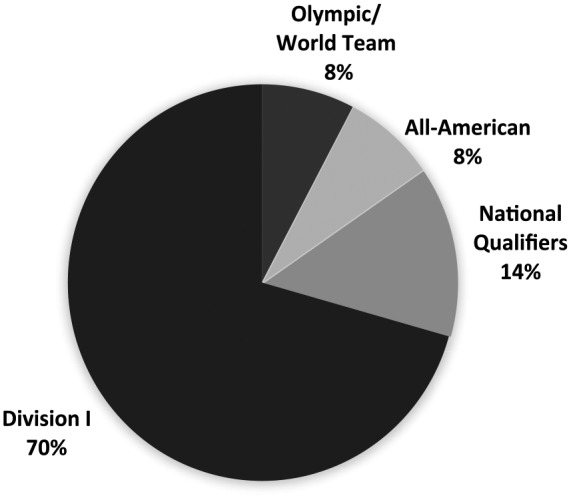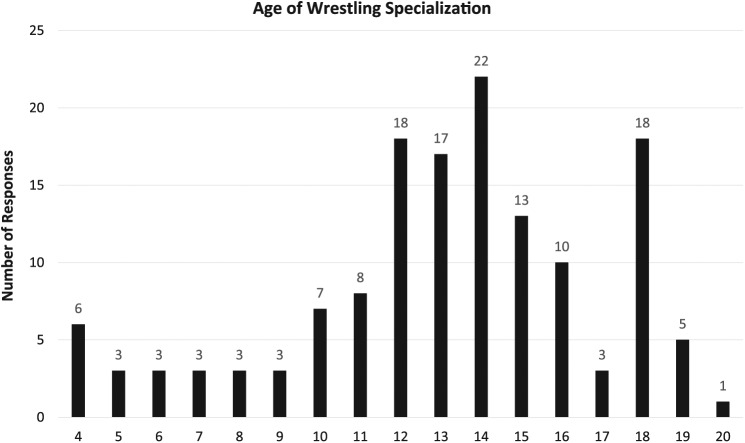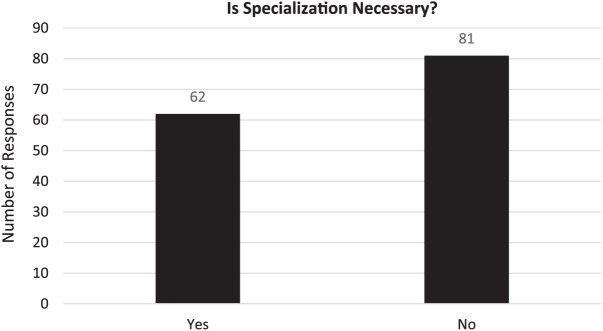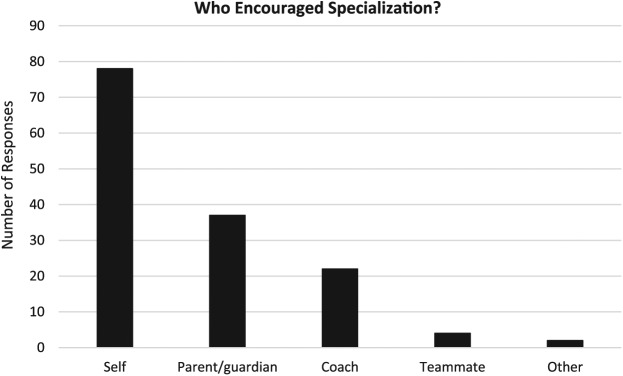Abstract
Background:
Sports specialization is becoming an increasingly common training strategy in young athletes. Very little research currently exists examining the occurrence of serious injury (>3 months off sport or loss of season) in elite-level wrestlers who specialize early (before age 12 years).
Hypothesis:
Wrestlers who specialize early will sustain more serious injuries than wrestlers who specialize at age 12 years or older.
Study Design:
Descriptive epidemiological study.
Methods:
We sent an anonymous online survey to a total of 312 elite-level wrestlers (National Collegiate Athletic Association Division I athletes and World/Olympic team members) containing questions documenting age of specialization and number of serious injuries sustained. The number of serious injuries both before and after starting college were compared between wrestlers specializing at <12 years old and ≥12 years old using an independent-samples t test. Respondents’ opinions on the necessity of early specialization and their primary source of encouragement to specialize were also reported.
Results:
A total of 143 wrestlers completed the survey, for a total response rate of 46%. Thirty-six (25%) wrestlers specialized at <12 years old. The early specialization group sustained significantly more serious injuries than the late specialization group (1.14 vs 0.60; P = 0.035). Sixty-two (43%) believed early specialization was necessary to achieve elite-level status. The decision to specialize was encouraged primarily by the athlete (78/143; 55%), parents (37/143; 26%), and coaches (22/143; 15%).
Conclusion:
Elite wrestlers who specialize prior to age 12 years sustain a greater number of serious injuries before starting college than those who specialize at or after the age of 12 years.
Clinical Relevance:
Athletes, coaches, and parents should consider the risk of injury before adopting a wrestling-specialized training strategy at a young age.
Keywords: early sports specialization, wrestlers, injury prevention, elite wrestling
Early sports specialization is becoming an increasingly common training strategy in young athletes and is defined by the AOSSM Consensus Statement as intensive training/competition in organized sports greater than 8 months per year, participation in 1 sport with the exclusion of all other sports, and involvement of children who are prepubertal or approximately 12 years of age.3,9,11,21 The rationale for specialized training in 1 sport largely originates from previous studies that have demonstrated the superiority of deliberate practice over innate ability with regard to performance capabilities.5 As society continues to incentivize attainment of elite athletic stature with monetary reward, athletic scholarships, and fame, sport specialization becomes an attractive training option to athletes who wish to achieve elite status. However, the value of sports specialization remains highly contested, and there are increasing accounts of early sport specialization that have led to burnout4 and increased injury.1,7,14,22,24 Furthermore, the AOSSM Early Sport Specialization Consensus Statement alleges that no evidence exists to indicate that failure to specialize early limits the long-term success of athletes.11
To date, sports specialization research has been predominantly focused on team sports such as soccer,15 basketball,20 baseball,8,12,13,16,25 ice hockey,2 and rugby.19 There is less research devoted to sports specialization in Olympic sports, and even less research focusing on wrestlers. A previous study of collegiate-level wrestlers characterized the epidemiology of wrestling-related injuries, and found that freshmen sustained the most injuries, likely indicating that experience level is a contributing factor to the likelihood of injury. The same study found that Division I wrestlers sustained the most injuries when compared with other collegiate athletes.10 However, we have yet to determine how early sport specialization in wrestlers can contribute to injury occurrence and the level of athletic success obtained.
Reaching a collegiate level in any particular sport can be challenging, and reaching a Division 1 level has an even lower probability. This is true to an even greater extent in wrestling, with National Collegiate Athletic Association (NCAA) data demonstrating that the percentage of high school participants who reach the collegiate level is the lowest of all sports in wrestling (2.9%) with even fewer reaching Division I level (1.0%).6 Although the push to specialize is occurring across multiple sports,17,18 the level of technical proficiency required of a Division I wrestler may lead to a greater push for parents and athletes to specialize earlier in life in attempt to gain an edge on the competition. Despite this, USA Wrestling has an athlete development model that does not advocate for sport specialization until the age of 18 years with multisport competition being a focus until that age.23
We therefore had 2 major objectives for this study: (1) to determine the mean age at which elite wrestlers specialize and (2) to compare the mean number of major injuries prior to college between those who specialized at <12 years of age and those who specialized at ≥12 years of age. We hypothesized that wrestlers specializing early would sustain more injuries than those who specialized later. Additionally, we sought to determine if elite wrestlers felt that early specialization was necessary to achieve elite status, who most influenced their decision to specialize, and the mean number of major injuries sustained after starting college.
Methods
Participants
An anonymous survey was sent to World and Olympic team members of USA Wrestling and collegiate wrestlers at NCAA Division 1 universities. A hyperlink to the survey was emailed to coaches of qualifying wrestlers via an online survey resource (SurveyMonkey), and subsequently forwarded to the wrestlers.
Survey questions included highest level of wrestling achieved, age at specialization, number of major injuries prior to college (<17 years of age), number of major injuries after starting college (≥17 years of age), who most encouraged them to specialize, and if they think specialization is necessary to become an elite-level wrestler. For our purposes, we defined early sports specialization using the guidelines presented within the AOSSM Early Sport Specialization Consensus statement. To minimize the potential for recall bias, a serious injury was considered one that required the athlete to miss the full wrestling season or spend 3 or more months away from sport.
Statistical Analysis
The mean number of injuries sustained prior to college was compared between wrestlers who specialized early (prior to 12 years of age) and those who specialized later (12 years of age or older) using an independent-samples t test. A Levene test for equality of variances found unequal variances between the early and late specialization groups. Thus, all t-test results were reported and interpreted assuming unequal variances. Statistical significance was determined a priori at α = 0.05. Descriptive statistics were reported for all survey responses.
Results
A total of 143 survey responses were collected; 3 respondents were omitted from data analysis due to incomplete surveys or nonsensical responses. The respondents comprised 11 World or Olympic Team members, 11 Division I All-Americans, 20 Division I National Qualifiers, and 101 Division I athletes (Figure 1).
Figure 1.

Highest level of competition achieved among survey participants (n = 143).
The mean age of specialization was 13.1 ± 3.82 years. A total of 25% of respondents (36 of 143) specialized prior to age 12 years, while the remaining 75% (107 of 143) specialized at 12 years or older (Figure 2). Of those specializing later, 19% (27 of 143) did not specialize until 17 years of age or older. Just less than half of respondents (43%) felt that early specialization was required to become an elite-level wrestler (Figure 3). Although 50% (18 of 36) of early specializers versus 41% (44 of 107) of late specializers felt that early wrestling specialization was necessary, the difference was not statistically significant, χ2(1) = 0.865, P = 0.352.
Figure 2.
Age at which the surveyed wrestlers specialized (n = 143).
Figure 3.
Number of wrestlers who felt that specialization is necessary to obtain elite status.
Overall, the respondents sustained an average of 0.74 ± 1.03 major injuries prior to college. Wrestlers specializing before age 12 years sustained significantly more major injuries (mean 1.14 ± 1.40) prior to college than those who specialized after age 12 years (mean, 0.60 ± 0.85) (mean difference, 0.54; 0.25; 95% CI [0.038, 1.03]; P = 0.035). There was no statistically significant difference in the mean number of major injuries sustained after college between those who specialized early and those who specialized later (mean difference, −0.08; SE, 0.22; 95% CI [−0.51, 0.35]; P = 0.717). A post hoc power analysis revealed—with α = 0.05 and 80% power—that a sample size of 450 would be needed to reliably detect a statistically significant difference.
The majority of athletes (55%, 78 of 143) reported that they were self-motivated to specialize, followed by 26% (37 of 143) who were encouraged by a parent/guardian, and 15% (22 of 143) who were encouraged by a coach (Figure 4).
Figure 4.
Distribution of responses for who most encouraged wrestling specialization.
Discussion
Sports specialization has become an increasingly common strategy for the achievement of elite status in athletics. In sports such as wrestling, which require extensive technical training, exclusion of all other sports-related training can present a seemingly attractive strategy to catalyze mastery of the sport. However, a recent study by Black et al2 has questioned the value of sports specialization, alleging that specialization is not necessarily indicative of success. The results of our study support this allegation with respect to wrestling, as 75% of athletes surveyed did not specialize early and 19% did not specialize until college. These results suggest that achievement of elite status is attainable without early specialization. Additionally, less than half of those surveyed felt that early specialization was necessary to achieve elite status. Although not statistically significant, this opinion was more common in those who specialized early. Because of its technical nature, it is likely that those who specialized in wrestling early felt that early specialization is necessary to facilitate mastery of technique. Opportunities for further exploration may include a survey of coaches to assess if wrestlers specializing prior to age 12 years are technically superior to those specializing later. Information obtained from this survey may gauge the necessity of early specialization for individuals without the innate athleticism to facilitate achievement of elite-level status.
The average age at which wrestlers specialized in our study was 13.1 years, which is lower than the previously reported ages of 14.8 and 14.7 years for specialization for NCAA and professional athletes, respectively.3 However, the same study indicated that athletes in individual sports specialized earlier than those in team sports. This tendency is a potential explanation for our relatively low mean age of specialization. The earlier age of specialization in our study can also be attributed to the technique-oriented nature of wrestling, which often requires more training to achieve the proficiency necessary to compete on middle school or high school teams. Further support for this hypothesis is our observation that the 3 most commonly occurring ages of specialization were 12, 14, and 18 years (Figure 2), corresponding to the ages at which students enter middle school, high school, and college, respectively. It is possible that the decision to specialize is a direct result of desire to optimize performance at each of these grade levels. Future research may focus separately on each of these age groups (and those who specialized prior to age 12 years) to explain these observations.
In addition to an earlier age of specialization, our study indicated higher occurrence of injury in wrestlers specializing prior to age 12 years. These results are consistent with those of previous studies. A previous study by Jayanthi et al9 has shown that early sports specialization is an independent risk factor for overuse injuries in sports. This study also demonstrated that early specialization led to a statistically significant difference in injury incidence prior to college, with injury occurrences plateauing at the collegiate level. Therefore, the results of both our study and those of Jayanthi et al9 suggest that early specialization may be putting young wrestlers at risk for injury at a younger age. Of note, our survey did not ask for the age of initiation of sport, which could explain lower occurrence of injury if a portion of the late specializers also did not begin wrestling until a later age.
We found that the decision to specialize within our study population was predominantly one of self-motivation. However, parents and coaches were the second and third most common influence on the decision to specialize, respectively. These results suggest that the decision to specialize is multifactorial and is also likely to involve the influence of parents and coaches. Thus, any future efforts to educate the public about the risk of injury from early sport specialization should be a didactic interaction between athletes, parents, and coaches.
Our study had several limitations. First, this was a cross-sectional, survey-based study of elite athletes. As such, our study population did not include a cross section of all competitive wrestlers, thereby failing to account for athletes affected by burnout, career-ending injuries, or failure to achieve elite status. The lack of data on age of initiation in wrestling as well as participation in other sports makes it difficult to determine if the higher injury incidences in our study are simply attributable to increased athletic exposure. A prospective, longitudinal study design that follows athletes from initiation of sport through specialization and beyond could be considered as a next step. Furthermore, our survey design limits the study’s ability to determine other factors that may influence the success and injury rates associated with sport specialization, specifically burnout, overuse injuries, and socioeconomic factors. Additionally, as a survey-based study, our results are subject to recall bias. We attempted to minimize the likelihood of recall bias by including only serious injuries that would require an athlete to miss either an entire wrestling season or 3 or more months away from sport.
Our survey is also limited by our failure to account for cross-training in different styles of wrestling, and the total amount of time spent in wrestling practices and/or matches. The style of wrestling in high school and college (folkstyle) differs from the international styles of wrestling (freestyle/Greco-Roman), in which youth wrestlers often cross-train. Although cross-training may decrease incidence of injury and burnout, we are unable to comment on the potential influence of cross-training on our results. Similarly, we are unable to distinguish if those athletes who specialized in wrestling spent more time in wrestling-related activities than those who did not specialize. Finally, we acknowledge our relatively low survey response rate and the lack of survey validation, which make it difficult to comment on the dependability and consistency of survey results. However, because there is no existing research of sports specialization in elite wrestlers to date, we feel the effects of these limitations are negligible. Overall, our results indicate that elite wrestlers specialize around a mean age of 13 years, and those who specialized before 12 years of age sustain more injuries than wrestlers who delay specialization until age 12 years or later. Additionally, the athlete, parents, and coaches all appear to be influential in the decision to specialize early. Because our results suggest that the incidence of injury is greater in those who specialize early, athletes, parents, and coaches should consider the potential risks of early specialization prior to committing to a specialized training regimen.
Footnotes
The authors report no potential conflicts of interest in the development and publication of this article.
References
- 1. Bell DR, Post EG, Trigsted SM, Hetzel S, McGuine TA, Brooks MA. Prevalence of sport specialization in high school athletics: a 1-year observational study. Am J Sports Med. 2016;44:1469-1474. [DOI] [PubMed] [Google Scholar]
- 2. Black S, Black K, Dhawan A, Onks C, Seidenberg P, Silvis M. Pediatric sports specialization in elite ice hockey players. Sports Health. 2019;11:64-68. [DOI] [PMC free article] [PubMed] [Google Scholar]
- 3. Buckley PS, Bishop M, Kane P, et al. Early single-sport specialization: a survey of 3090 high school, collegiate, and professional athletes. Orthop J Sports Med. 2017;5:232596711770394. [DOI] [PMC free article] [PubMed] [Google Scholar]
- 4. DiFiori JP, Benjamin HJ, Brenner JS, et al. Overuse injuries and burnout in youth sports: a position statement from the American Medical Society for Sports Medicine. Br J Sports Med. 2014;48:287-288. [DOI] [PubMed] [Google Scholar]
- 5. Ericsson KA, Krampe RT, Tesch-Romer C. The role of deliberate practice in the acquisition of expert performance. Psychol Rev. 1993;100:363-406. [Google Scholar]
- 6. Estimated probability of competing in college athletics. NCAA.org—The Official Site of the NCAA. http://www.ncaa.org/about/resources/research/estimated-probability-competing-college-athletics. Published April 23, 2018. Accessed December 5, 2018.
- 7. Feeley BT, Agel J, LaPrade RF. When is it too early for single sport specialization? Am J Sports Med. 2016;44:234-241. [DOI] [PubMed] [Google Scholar]
- 8. Fleisig G, Andrews J, Cutter G, et al. Risk of serious injury for young baseball pitchers: A 10-year prospective study. Am J Sports Med. 2011;39:253-257. [DOI] [PubMed] [Google Scholar]
- 9. Jayanthi N, Pinkham C, Dugas L, Patrick B, Labella C. Sports specialization in young athletes: evidence-based recommendations. Sports Health. 2013;5:251-257. [DOI] [PMC free article] [PubMed] [Google Scholar]
- 10. Goodman AD, Twomey-Kozak J, DeFroda SF, Owens BD. Epidemiology of shoulder and elbow injuries in National Collegiate Athletic Association wrestlers, 2009-2010 through 2013-2014. Phys Sportsmed. 2018;46:361-366. [DOI] [PubMed] [Google Scholar]
- 11. LaPrade RF, Agel J, Baker J, et al. AOSSM early sport specialization consensus statement. Orthop J Sports Med. 2016;4:2325967116644241. [DOI] [PMC free article] [PubMed] [Google Scholar]
- 12. Lyman S, Fleisig GS, Andrews JR, Osinski ED. Effect of pitch type, pitch count, and pitching mechanics on risk of elbow and shoulder pain in youth baseball pitchers. Am J Sports Med. 2002;30:463-468. [DOI] [PubMed] [Google Scholar]
- 13. Lyman S, Fleisig GS, Waterbor JW, et al. Longitudinal study of elbow and shoulder pain in youth baseball pitchers. Med Sci Sports Exerc. 2001;33:1803-1810. [DOI] [PubMed] [Google Scholar]
- 14. Myer GD, Jayanthi N, Difiori JP, et al. Sports specialization, part I: does early sport specialization increase negative outcomes and reduce the opportunity for success in young athletes? Sports Health. 2015;7:437-442. [DOI] [PMC free article] [PubMed] [Google Scholar]
- 15. O’Kane JW, Neradilek M, Polissar N, Sabado L, Tencer A, Schiff MA. Risk factors for lower extremity overuse injuries in female youth soccer players. Orthop J Sports Med. 2017;5:2325967117733963. [DOI] [PMC free article] [PubMed] [Google Scholar]
- 16. Olsen SJ, Fleisig GS, Dun S, Loftice J, Andrews JR. Risk factors for shoulder and elbow injuries in adolescent baseball pitchers. Am J Sports Med. 2006;34:905-912. [DOI] [PubMed] [Google Scholar]
- 17. Padaki AS, Ahmad CS, Hodgins JL, Kovacevic D, Lynch TS, Popkin CA. Quantifying parental influence on youth specialization: a survey of athletes’ parents. Orthop J Sports Med. 2017;5:2325967117729147. [DOI] [PMC free article] [PubMed] [Google Scholar]
- 18. Padaki AS, Popkin CA, Hodgins JL, Kovacevic D, Lynch TS, Ahmad CS. Factors that drive youth specialization. Sports Health. 2017;9:532-536. [DOI] [PMC free article] [PubMed] [Google Scholar]
- 19. Phibbs PJ, Jones B, Roe G, et al. Organized chaos in late specialization team sports: weekly training loads of elite adolescent rugby union players. J Strength Cond Res. 2018;32:1316-1323. [DOI] [PubMed] [Google Scholar]
- 20. Rugg C, Kadoor A, Feeley BT, Pandya NK. The effects of playing multiple high school sports on National Basketball Association players’ propensity for injury and athletic performance. Am J Sports Med. 2018;46:402-408. [DOI] [PubMed] [Google Scholar]
- 21. Smith AD, Alleyne JM, Pitsiladis Y. Early sports specialization: an international perspective. Curr Sports Med Rep. 2017;16:439-442. [DOI] [PubMed] [Google Scholar]
- 22. Smucny M, Parikh SN, Pandya NK. Consequences of single sport specialization in the pediatric and adolescent athlete. Orthop Clin North Am. 2015;46:249-258. [DOI] [PubMed] [Google Scholar]
- 23. TheMat.com—The Official Website of USA Wrestling. http://content.themat.com/CoachesCorner/LTADPoster.pdf. Accessed February 12, 2019.
- 24. Valovich McLeod TC, Decoster L, Loud KJ, et al. National Athletic Trainers’ Association position statement: prevention of pediatric overuse injuries. J Athl Train. 2011;46:206-220. [DOI] [PMC free article] [PubMed] [Google Scholar]
- 25. Wilhelm A, Choi C, Deitch J. Early sport specialization: effectiveness and risk of injury in professional baseball players. Orthop J Sports Med. 2017;5:2325967117728922. [DOI] [PMC free article] [PubMed] [Google Scholar]





